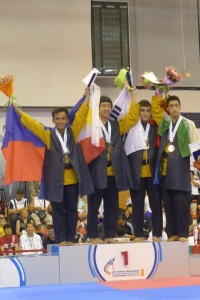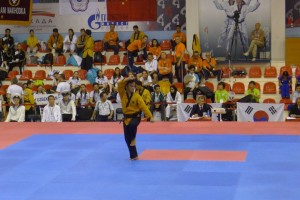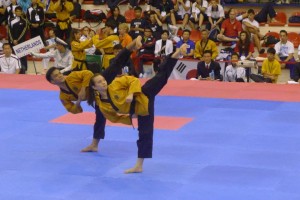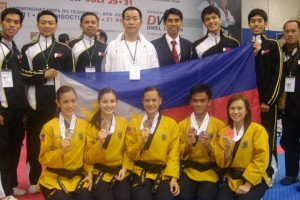Small town kid bags silver in World Taekwondo meet
Nueva Vizcaya wonder boy’s secret: pancakes
INQUIRER.net
VLADIVOSTOK, Russia – An hour after bagging the silver medal in dramatic fashion at the 6th world Taekwondo Poomsae Championships over the weekend, in this historic port city by the sea, 17-year-old Marvin Gabriel’s joy over his achievement was overtaken by his youthful wonder that a tall, blond, blue-eyed nurse was now personally collecting his urine sample, a random doping procedure for select athletes who had ostensibly displayed suspicious domination in their respective divisions.

MARVELOUS MARVIN smiles for the crowd with champion Korea, and third placers Turkey and Iran. CONTRIBUTED PHOTO
“Medyo na-weirdan ako dahil di niya ako pinatalikod habang jumi-jingle ako sa bote..titig na titig sa akin. Baka tuloy kung ano mangyari… (“I felt a bit weird because she stared at me while I peed into the bottle. Something embarrassing could happen”),” he laughed.
Informed that the test’s objective was to make sure he hadn’t taken any performance-enhancing drugs, Gabriel turned serious. “Do you think pancakes count? I’ve been a eating a lot of them during training,” he asked.
Gabriel’s touching weltanschauung (world view), momentarily masked the stunning impact of his near flawless performance earlier in the day when the rookie Taekwondo-jin from the boondocks of Solano town, Nueva Vizcaya, in the main island of Luzon, finished a threatening second to Korea’s Yu-seok Kim in the 14-18 men’s individual juniors division, while completely demolishing powerhouse veteran martial artists from all over the world, including Turkey’s Habip Okeu and Iran’s Mohamed Aderi, who eventually shared the bronze.
Toughest category
Gabriel’s achievement electrified the capacity crowd at the 5,000-seat Olympic Sports Complex at the Vladivostok sports arena, many of whom marvelled at the diminutive, but sleekly-muscled Filipino who came from nowhere to display controlled power, focus and poise while performing the difficult Taekwondo forms of Taeguk 7, Koryo, Keumgang and Taebek. When the smoke had cleared, Gabriel, a University of Santo Tomas (UST) freshman studying applied physics, had nailed the first medal won by the Philippines in an event long considered as one of the toughest categories in world competitions that began in 2006.
Small wonder then when tournament officials immediately earmarked Gabriel for drug testing (which he passed with flying colors), due to the strikingly muscular impact of his performance, sheathed in unerring accuracy and ‘clean poomsae lines’, all packaged in rhythmic grace and tempo.
Poomsae was introduced at the Southeast Asian Games in 2009 and will make its Asian Games debut in Inchon in 2014. Poomsae is like kata in karate where an athlete is judged in terms of mastery, accuracy, speed and strength showing fighting form against an imaginary opponent. Poomsae does not involve sparring and isn’t a contact sport.
Rigorous training

KEUMGANG. Marvin Gabriel displays iron balance in the finals of the junior men’s individual division to nail the first medal won by the Philippines, in an event long considered as one of the toughest categories in world ‘poomsae’ competitions that began in 2006. CONTRIBUTED PHOTO
“Marvin strong, work hard. I promise…Marvin win many, many more medals for Philippines in future world championships,” said Philippine team coach, South Korean Jeong Tae Seong, in his trademark, halting English.
The naturally friendly Jeong, who turns taciturn taskmaster inside the central gym headquarters of the Philippine Taekwondo Association (PTA) in downtown Manila, is himself a legendary Taekwondo coach and acknowledged trainer of Poomsae champions in Kukkiwon, the mecca of Taekwondo in Seoul, South Korea. Over the last two months, he admitted using his iron will and technical know-how fashion a rigorous training regimen that ultimately forged Gabriel, and his teammates in the national team, into a disciplined fighting unit, now envied by many Taekwondo-practicing countries all over the world.
Paving the way
Gabriel’s silver fired up Philippine team to win more medals over the three-day competition.
On the second day, the dusky Taekwondo-jin claimed a bronze in the first pairs division with 18-year-old Shaneen Sia, another UST student and a freshman of the Manila-based Taekwondo Blackbelt Sorority (TBS). This was soon followed by another bronze medal from cousins Rani Ann Ortega, Janice Lagman and Camille Alarilla, in the women’s first team event.
Ortega, Lagman and Alarilla capped the Philippines’ harvest with a bronze, pushing the country up to 10th place overall in the medal standings. There were 570 athletes from 52 countries in the three-day meet where 18 gold medals went up for grabs. Other countries that garnered medals but ranked below the Philippines were China, Denmark, Turkey, Belgium, Canada, Colombia, Holland and Thailand.
The Philippines also won a bronze medal in the free-style poomsae exhibition matches, which featured a routine with taekwondo techniques performed to music and choreography. Vietnam won the gold with a 7.58 score and Turkey, the silver with 7.50. The Philippines tallied 7.38.
Free-style poomsae is now being introduced as a regular event in international Taekwondo competitions to blend the ancient tradition with new, dynamic and artistic forms.
The Philippines had brought home a gold in each of the last two stagings of the world championships. At the fourth championships in Cairo, Ortega, Lagman and Alarilla won in the women’s first team event in 2009.
Last year, Jean Pierre Sabido, Brian Sabido and Anthony Ray Matias captured the gold in the men’s first team event.

TAEBEK. Marvin Gabriel and Shaneen Sia throw synchronized side kicks in the finals, to win the bronze medal in the junior pair division. CONTRIBUTED PHOTO
“Although we didn’t win gold this time, the team performance really went up with the new medals in the individual and pairs events where we had never won medals before,” said head of delegation Igor Mella.
“Our world champion ladies team returned to the podium with a third place finish, an improvement from fifth last year. We’re excited and encouraged by the performance of Marvin and Shaneen. They teamed up for the first time in the world championships and brought home a bronze with Russia finishing first and Vietnam second.”
Brian Sabido and Matias did not compete this year, leaving Jean Pierre Sabido as the only holdover from the men’s first team champion. Sabido teamed with new partners Gabriel and Galilee Tinaya to finish eighth.
The Philippines’ first medal in the world championships came in 2008 when the Sabido brothers and Matias took the bronze in the men’s first team event in Ankara, Turkey.
Banner field of taekwondo-jins
Topping the competitions this year in Vladivostok was Korea with nine gold medals and a silver. Vietnam was second with two golds, four silvers and a bronze. Germany had two golds, two silvers and a bronze.
Chinese-Taipei took two golds, a silver and five bronzes.
The tournament set age groups for different events. The first pairs had a range of 14 to 35 and the second pairs, 36 and over. Singapore nun Sister Linda Sim, 56, competed in the women’s individual second masters class. The men’s third individual masters class brought in competitors 61 and over while the men’s first individual masters class, 41 and over.
The event drew the largest participation of athletes since its inception. The US showed up with 24 athletes but none took a medal. Iran had 23 competitors, Russia 21 and Chinese-Taipei.
A total of 60 international Taekwondo poomsae referees officiated in the event.
The opening ceremony featured various programs, such as a Russian Taekwondo demonstration, and a 15-minute power-breaking, sparring and self-defense display by the WTF demonstration team.
There was also a five-member demonstration team competition involving four countries — Turkey, Azerbaijan, Russia and Korea. The latter won the competition.
Martial arts warriors
This year’s tournament also unveiled a new competition uniform, or the “dobok” approved for universal use by the federation. Tournament officials explained that the new uniform brought back the “sense of authenticity” of the poomsae discipline.
But for the young Gabriel, he acknowledged not having the time nor the inclination to explore the roots and philosophical aspects of the poomsae discipline, or the new uniforms, before or after the championships.
“We did nothing but train hard, push hard and condition our minds and bodies for the last two months, and the crucial week going into the competition,” Gabriel revealed. “Our strategy was, as Master Jeong taught us, to have a ‘competition mind’ everytime we train. No relaxing allowed. “
“Actually, towards the end, the competition itself had stopped being our goal: training with 100 percent effort became our goal…without making any mistakes,” Gabriel said.
For Gabriel, and his teammates in the national team, they had become true martial arts warriors: the journey had become their destination.
Pancakes galore
Next stop for Gabriel and the national team is the 2011 World Hanmadang Competitions in Namyangju South Korea from August 10-14, where the Filipino-jins are the defending champions in the team category.
The athletically-demanding Hanmadang competitions consists of synchronized creative poomsae and power-breaking demonstrations.
The team will then fly to Shenzhen, China to compete against battle-hardened medallists from the World, Olympic and Continental Championships in the three-day 26th World University Games.
Intensive mind and body preparations have ostensibly become the norm for the young Gabriel. Queried about his stamina to compete relentlessly in such high-level competitions, while juggling his studies at UST, he had a ready answer: “Pancakes….lots of it”

No comments:
Post a Comment